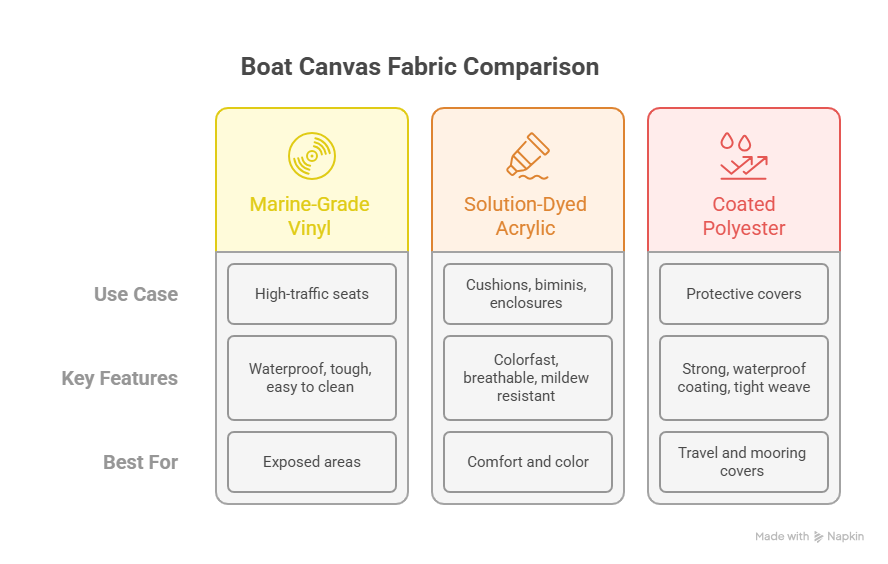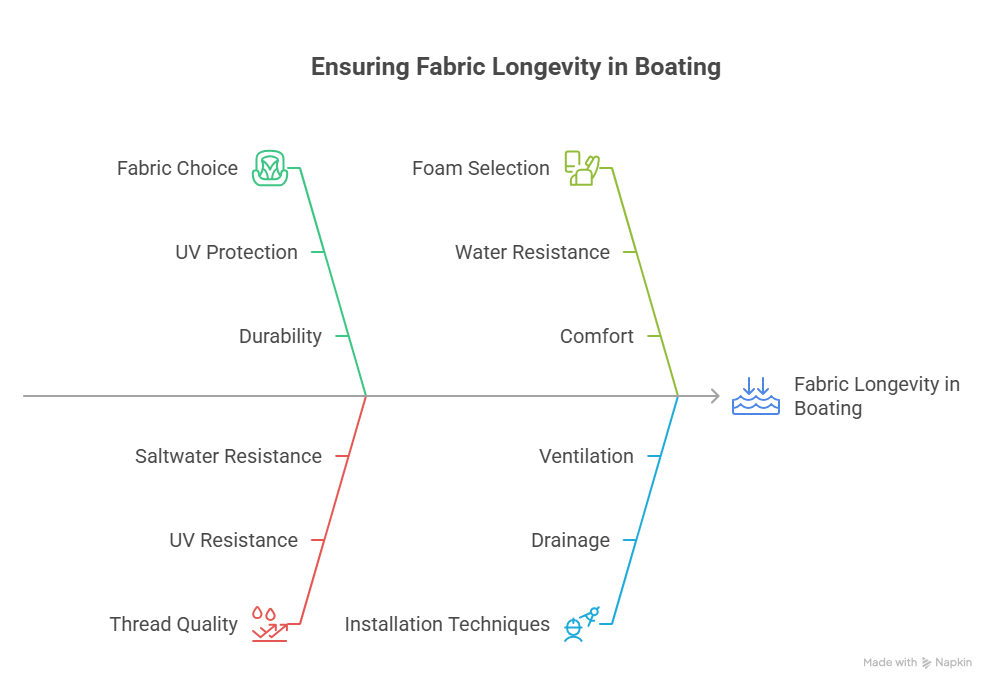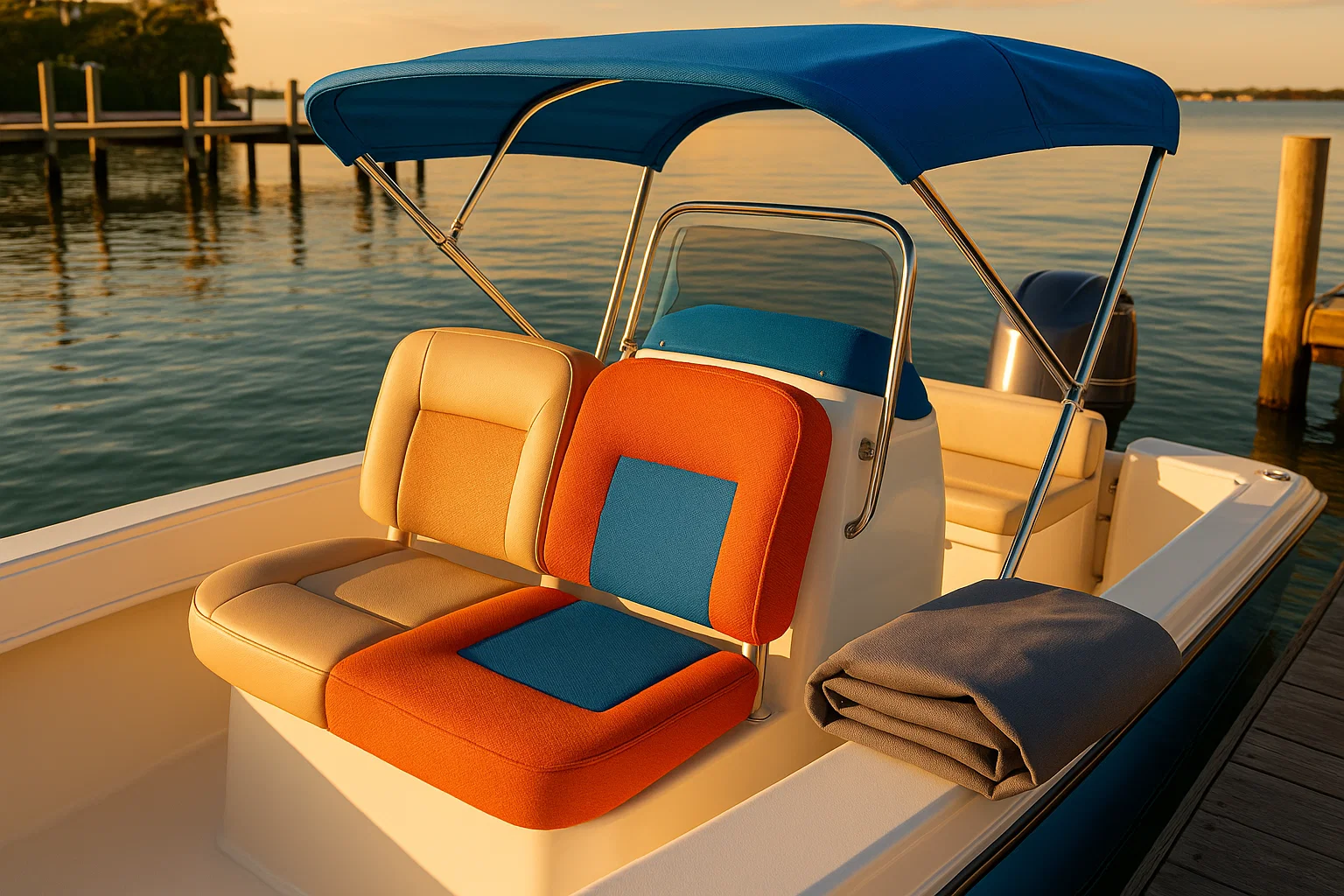Boat Canvas Fabric: 15 Years of Choosing What Works on the Water
I’ve been fixing up boats in South Florida for 15 years, from Miami’s Dinner Key Marina to Fort Lauderdale’s Bahia Mar. Nothing stings more than pulling back a boat cover after a season to find faded, cracked, or mildew-stained cushions. Last June, a client named Carlos brought his 2021 Sea Ray 230 to my shop in Coconut Grove—his cockpit seats were trashed after just two years. The culprit? Cheap fabric and shoddy thread that couldn’t handle the sun and salt. Here’s what I’ve learned about picking boat canvas fabric that lasts, so you can avoid Carlos’s $2,500 reupholstery bill and keep your boat looking sharp.
This guide breaks down everything you need to know about marine-grade fabrics—vinyl, acrylic, polyester—and the unsung heroes like thread and foam. I’ll share tips from my years on the water, plus a few tricks to make your upholstery job bulletproof. Whether you’re a weekend angler or a liveaboard cruiser, you’ll find the right materials to match your boating style.
Table of Contents
Why Does Boat Canvas Fabric Matter So Much?
Boat upholstery isn’t just about looks—it’s a big investment that takes a beating from sun, saltwater, and wear. Pick the wrong fabric, and you’re stuck with faded cushions or moldy covers in a season. I learned this the hard way back in 2010 when I used off-brand vinyl on a buddy’s Boston Whaler. It cracked in a year, and I was out $1,000 fixing my mistake. Choosing the right fabric means less maintenance and more time on the water.
What Makes a Fabric Truly Marine-Grade?
Not every fabric can handle life on a boat. Marine-grade means it’s built to fight three enemies: UV rays, moisture, and physical wear. I’ve seen too many owners fall for “bargain” fabrics that fade or tear fast. Here’s what you need to focus on, based on my jobs in Miami’s brutal climate.
How Do UV Rays Destroy Boat Fabrics?
South Florida’s sun is relentless—UV rays break down fibers, turning bright blues to pale grays. I use a UV tester on fabrics before recommending them; anything below 1,500 hours of UV resistance won’t cut it. Solution-dyed acrylics like Sunbrella are my go-to because the color’s locked into the fiber, not just coated on. Last summer, I redid a client’s bimini at Key Biscayne with Sunbrella—it’s still vibrant after a year of daily sun.
Why Is Moisture Resistance Critical for Boat Fabrics?
Saltwater and humidity are mildew’s best friends. I’ve cut open cushions that looked fine but were rotting inside because the fabric trapped moisture. Breathable fabrics like acrylic let humidity escape, while waterproof vinyl stops water cold. For a guy’s Grady-White 208 last month, I used vinyl for cockpit seats and acrylic for cabin cushions—kept everything dry and mold-free.
How Does Abrasion Resistance Keep Fabrics Intact?
Boats get rough treatment—passengers sliding, gear banging, snaps rubbing. I test fabrics with a Wyzenbeek machine (measures abrasion cycles); good marine fabrics handle 50,000+ cycles. Polyester’s tight weave makes it a beast for covers, while vinyl’s toughness is perfect for seats. I once saw a client’s cheap polyester cover tear in a storm off Stiltsville—$800 lesson learned.
What Are the Best Boat Canvas Fabrics for Your Boat?
Three fabrics dominate marine upholstery, each with a specific job. Here’s how I use them, based on 200+ upholstery jobs in South Florida.
Why Choose Marine-Grade Vinyl for High-Traffic Areas?
Vinyl’s the workhorse for seats that take a beating—think cockpit or helm stations. It’s PVC-based, practically waterproof, and tough as nails. I used Morbern vinyl on a fishing charter’s seats in Fort Lauderdale last year; they’re still spotless despite daily fish guts and saltwater. Vinyl’s easy to wipe clean with soap and water, and brands like Sunbrella Horizon add anti-microbial coatings. It’s not the softest, but for exposed areas, it’s unbeatable.
When Is Solution-Dyed Acrylic the Right Choice?
For cushions, biminis, or enclosures where comfort and color matter, solution-dyed acrylic shines. Sunbrella Marine Grade is my top pick—its color is mixed into the fiber, so it won’t fade, even after years in Miami’s sun. I reupholstered a client’s Sea Ray 350 cabin cushions in 2023; they’re still bright red and soft. Acrylic’s breathable, so moisture escapes, preventing mildew. You can even clean it with bleach without wrecking it.
Why Use Coated Polyester for Protective Covers?
Coated polyester isn’t for sitting—it’s for shielding your boat. Its tight weave and waterproof coating make it crazy strong. I used Top Gun polyester for a mooring cover on a client’s yacht in Bahia Mar last spring; it’s held up through storms without a tear. It’s stiff but perfect for travel covers or enclosures. If you’re trailering or docking in rough conditions, this is your fabric.
How Do You Choose the Right Fabric for Your Boating Style?
Your boat’s use decides the fabric. Here’s how I match materials to clients’ needs in South Florida.
What’s the Best Fabric for Day Cruisers in Sunny Climates?
If you’re cruising Miami’s coast, UV protection is key. Solution-dyed acrylic like Sunbrella keeps biminis and cushions vibrant. For helm seats, I’d go with Sunbrella Horizon vinyl—it’s tough and cleans easily. A client at Coconut Grove used this combo on his 2024 Bayliner; it’s still pristine.
What Fabric Works for Anglers or Watersports Families?
Fishing or watersports means hooks, saltwater, and chaos. Marine vinyl’s your best bet—wipes clean and laughs off abrasions. I did a center console’s seats with Naugahyde for a Key West angler in July 2024; he’s had zero issues. Pair it with a Top Gun polyester cover for storage.
What’s Ideal for Liveaboards or Long-Distance Cruisers?
Liveaboards need durability and comfort. Use vinyl for exposed seats and acrylic for cabin cushions. I worked on a liveaboard’s Hatteras in Fort Lauderdale last year—vinyl on the flybridge, Sunbrella in the salon. It’s held up perfectly, and the owner loves the plush feel below deck.

Why Are Thread and Foam Just as Important as Fabric?
Fabric gets the spotlight, but thread and foam can make or break your upholstery. I’ve seen $3,000 jobs fail because of cheap components.
Why Does Marine-Grade Thread Matter?
Seams are the weak link—standard thread rots in a season under UV and salt. PTFE thread like Tenara is my go-to; it’s UV-proof and guaranteed for life. I used it on a client’s bimini in Stiltsville in 2023—still rock-solid. UV-bonded polyester is a cheaper option but won’t last as long. Don’t skimp here; it’s a $200 upgrade that saves thousands.
How Do You Choose the Right Foam for Boat Cushions?
Foam decides comfort and mildew resistance. Closed-cell foam is non-absorbent, perfect for cockpit seats that get soaked. I used it on a client’s Boston Whaler last summer; no waterlogging, even after a storm. Reticulated (open-cell) foam dries fast and feels plush—great for cabin cushions with Sunbrella. Pair the foam with your fabric’s breathability for best results.
How Does Installation Affect Fabric Longevity?
Even the best materials fail without proper installation. I ensure cushions have mesh bottoms or weep holes for drainage. For a yacht in Key Biscayne, I added ventilation channels—kept cushions dry through a wet season. Clean vinyl with soap, acrylic with bleach-safe solutions, and rinse polyester covers regularly to remove salt.

FAQ: Common Boat Canvas Fabric Questions
What’s the Best Fabric for Boat Upholstery?
Marine-grade vinyl for high-traffic seats, solution-dyed acrylic like Sunbrella for cushions and biminis, and coated polyester for covers. I used Sunbrella on a Sea Ray’s cushions in 2023—still looks new. Match the fabric to your boating style for durability.
How Long Do Marine Fabrics Last?
With proper care, Sunbrella acrylic lasts 10–15 years, vinyl 7–10 years, and polyester covers 5–8 years. I’ve seen Sunbrella biminis in Miami hold color for a decade. Regular cleaning and PTFE thread extend lifespan.
Why Is Sunbrella So Popular for Boats?
Sunbrella’s solution-dyed acrylic locks in color and resists UV and mildew. I redid a client’s bimini at Dinner Key in 2024; it’s still vibrant. Its breathability and bleach-cleanability make it a favorite.
Can I Use Regular Fabric for Boat Upholstery?
No—regular fabric fades and molds fast. I tried a cheap polyester on a buddy’s boat in 2010; it was trash in a year. Stick to marine-grade materials like vinyl or Sunbrella for longevity.
How Do I Clean Marine Fabrics?
Vinyl needs soap and water; avoid harsh cleaners. Acrylic like Sunbrella handles bleach solutions. Polyester covers need regular rinsing. I cleaned a client’s vinyl seats in Fort Lauderdale last month—good as new.
What’s the Best Thread for Marine Upholstery?
PTFE thread like Tenara is UV-proof and lifetime-guaranteed. I used it on a yacht’s cover in 2023; seams are still perfect. UV-bonded polyester is a budget option but less durable.
How Do I Prevent Mildew on Boat Cushions?
Use breathable acrylic or waterproof vinyl with reticulated or closed-cell foam. Ensure drainage with mesh bottoms. I fixed a moldy cushion in Coconut Grove by swapping to Sunbrella and reticulated foam.
How Much Does Boat Upholstery Cost?
Costs range from $500 for small seats to $5,000 for a full reupholstery. I did a Sea Ray’s cockpit for $2,000 in 2024. Quality materials like Sunbrella and PTFE thread save money long-term.
Where Can I Get Fabric Samples?
Request samples from suppliers like Sunbrella or Morbern. I always grab samples for clients to feel the difference. Check sunbrella.com or local marine shops in Miami.
Why Is Foam Important for Boat Upholstery?
Closed-cell foam stops water absorption in exposed areas; reticulated foam dries fast for comfort. I used closed-cell foam on a Boston Whaler’s seats—kept them dry through a storm.
Conclusion: Invest in Fabrics That Last
Choosing boat canvas fabric isn’t just about picking a pretty color—it’s about protecting your boat’s value. I’ve seen too many owners, like Carlos with his Sea Ray, lose thousands on bad upholstery choices. Match vinyl to high-traffic seats, acrylic to comfy cushions, and polyester to rugged covers. Use PTFE thread and the right foam—closed-cell for exposure, reticulated for plush areas. Request samples from Sunbrella or Morbern, and work with a shop that knows marine-grade materials. With these choices, you’re not just reupholstering—you’re ensuring years of worry-free boating.
Author Bio
I’m Alex, a marine upholstery specialist with 15 years of experience in South Florida, from Miami to Fort Lauderdale. I’ve reupholstered 200+ boats, earning ABYC certification in 2010. My work keeps boats looking sharp and lasting longer in brutal marine conditions.


Leave a Reply